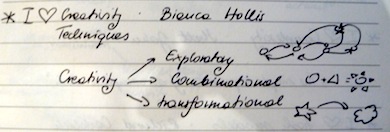I ♥ UX
Last Thursday I attended UKUPA event I [heart] UX. The format for the evening was a series of 10-minutes-long lightning talks, all with a common theme: I [heart] [something related to UX]. Here’s a short summary of the talks:
I ♥ Walls
John Waterworth talked about walls and how valuable they are, especially for collaboration. They can be used instead of boring ppt files for presenting concepts and findings – more information is visible after all. He also provided some tips on what to do when there’s no wall: use glass, windows, whiteboards, foamboards, etc. My favourite quote: “The more I love my wall, the more it loves me back”. There are no slides as the talk was presented on the wall.
I ♥ Participatory Design
Angel Brown talked about participatory design in general (it started in 70s in Scandinavia) and even listed some names, which I didn’t capture (hope the slides will be posted online). What surprised me the most was the fact that good old paper prototypes can be used for participatory design. It sounds like an obvious thing but I had it coded in my head that this works only with physical designs, not websites. I blame cardboard for that.
I ♥ Creativity Techniques
Bianca Hollis focused mainly on her MSc thesis on creativity techniques. There are three main types of those techniques: exploratory, combinational and transformational. She had nice little pictures to illustrate them which were really self-explanatory so I copied them to my notes:

I ♥ Listening
Stavros Garzonis talked about listening and highlighted that UX practitioners should listen between the lines and embrace/learn more about wu wei – knowing when to act and when not. He also pointed out we had to empathize with both users and clients. In the second half of his talk he moved to auditory notifications: to work for the users they must be intuitive, learnable, memorable and likeable.
I ♥ Mobile
Belen Pena focused on mobile worldwide. After presenting some examples from developing countries (M-PESA in Kenya, mPedigree in Nigeria or BabaJobs in India) and listing some eye-opening statistics (100% phones worldwide provide voice and text messages, 95% support HTML, 80% support MMS and only 13% support apps) she concluded we should look around, consider the context and change the world without jumping straight to an easy option of an iPhone app.
See the slides on Belen’s posterous
I ♥ Complexity
Shayal Chibberr talked about complexity and that it’s not necessarily a bad thing. He showed some interesting examples of research projects that included stalking following people in the shopping malls or redesigning packaging for haemophilia drugs. He finished with a quote: “The simple expression of a complex task” – complexity is good and it can be presented in a simple way without losing its value.
I ♥ Task Models
The last speaker was Richard Caddick talking about task models. As research leads to understanding user behaviour, it is possible to design the product around this model and support it. There are three main task models: linear (moving from point A to B, from a checkout page to a confirmation page), evaluation-driven (moving between various pages, e.g. trying to compare options before buying a car) or totally chaotic.
See the slides on Slideshare
~Falka, 20 February 11
Powered by Textpattern. Design by Falka. 2010-2025.
